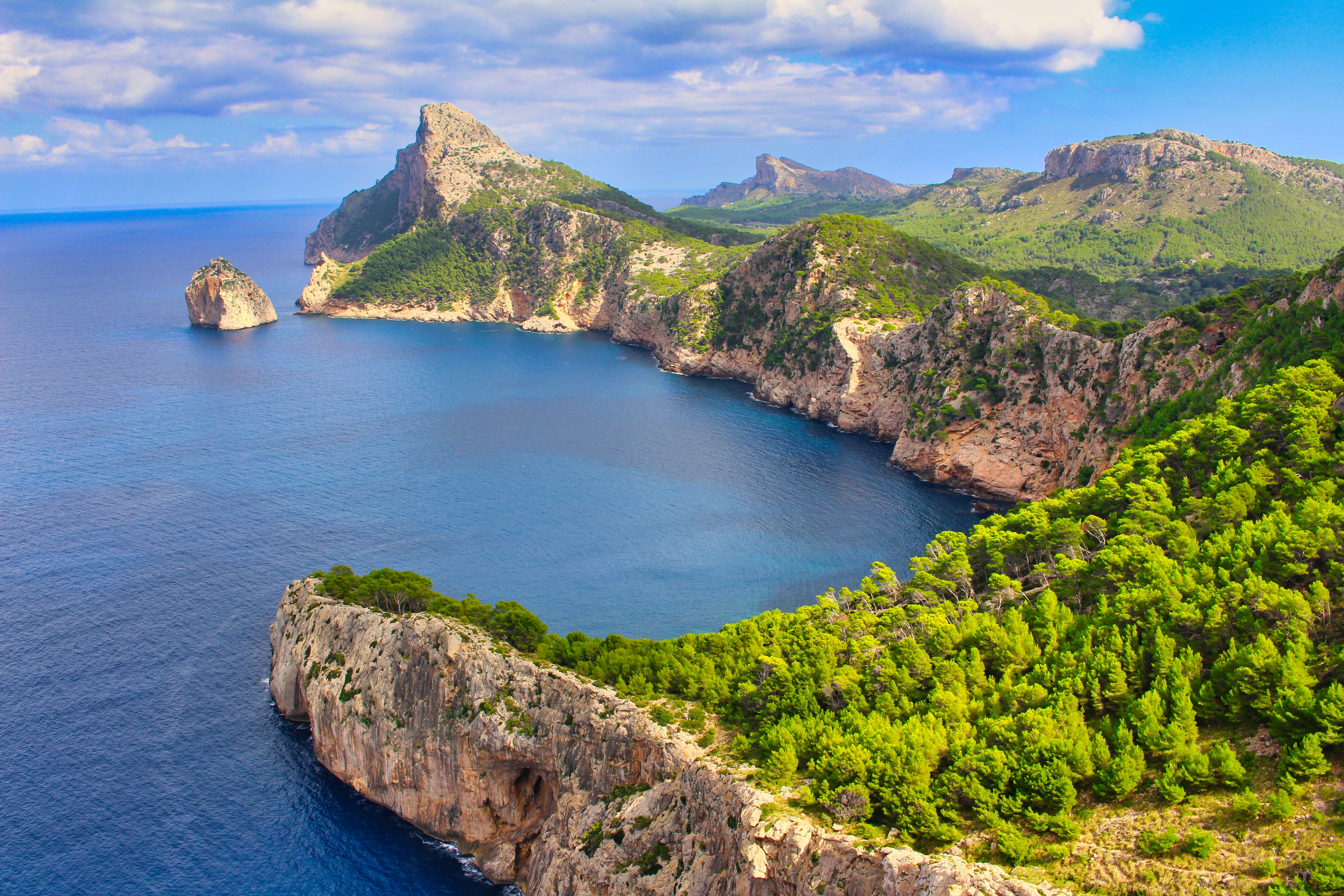
Just off the coast of Spain, the Balearic Islands are home to easygoing beach hideaways and cosmopolitan seaside resorts. Each island has a different personality, with options for all types of getaways, whether you’re looking for a quiet romantic escape or an active family vacation.
Mallorca is the largest of the islands, with historic sites in Palma, scenic mountain villages and sandy coves. Menorca is quieter, known for unspoiled nature, secluded beaches and laid-back coastal towns. Ibiza’s nightlife may be world renowned but it also has a cultural side, with UNESCO-listed sites and scenic countryside. Formentera is the smallest island, with gorgeous beaches and a relaxed vibe. In any of the islands, travelers can explore local markets, try Mediterranean cuisine and experience cultural traditions.
Discover how to pick the island that’s right for you, and get tips for the top things to do and where to stay across the Balearic Islands.
Need to know
A warm “hello” is the norm when greeting locals. Dining is a leisurely experience meant to be enjoyed with shared dishes. Respect local customs by keeping noise levels low, being mindful of beach etiquette and dressing appropriately when visiting religious sites.
Time is displayed in the 24-hour format (15:00 instead of 3pm). Type C and F plugs are used at 230 volts, so be sure to bring an adapter and converter if needed. For those visiting in the summer, book accommodations well in advance, especially in hotspots like Ibiza and Mallorca.
The islands are generally safe, with modern medical facilities in major cities like Palma, though travel insurance is recommended.
Renting a car in Mallorca is Fora Advisor Zoe Schaeffer’s biggest tip. “Palma is a beautiful city with artisan finds and elevated food, but Mallorca is big and you will want to explore the whole island,” Zoe said.
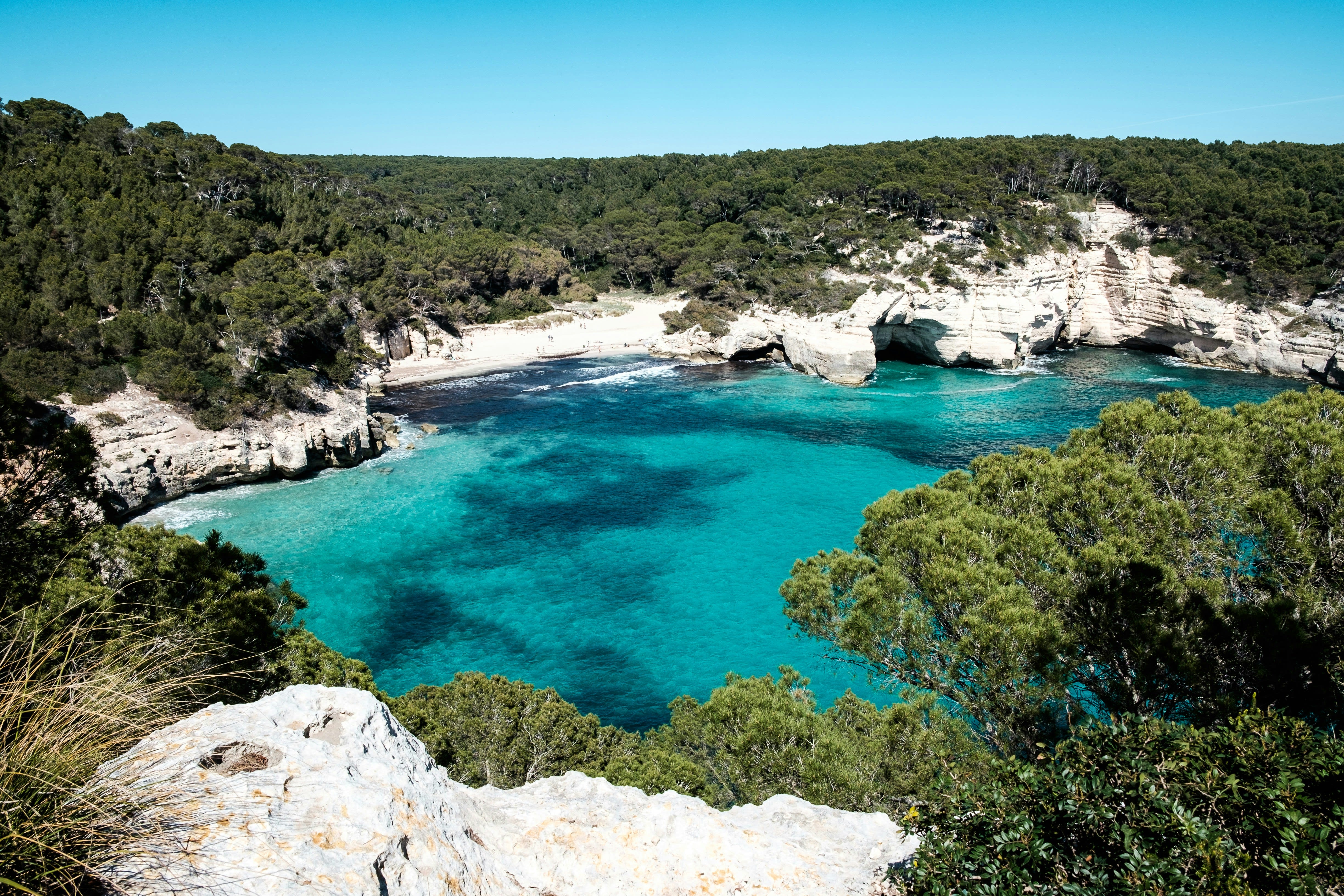
Currency: The Euro (EUR) is the official currency across the Balearic Islands. ATMs are widely available and most places accept credit cards, but it’s always best to carry some cash for smaller shops and markets.
Languages: Spanish is the official language of Spain, including the Balearic Islands.
Airports
Mallorca: Palma de Mallorca Airport (PMI) is the island’s main gateway, with flights from most major European cities. From the US, Newark (EWR) offers a weekly direct flight but most flights will connect through other European hubs.
Menorca: Menorca Airport (MAH) has direct flights from major Spanish cities and European hubs.
Ibiza: The main airport, Ibiza Airport (IBZ), handles both domestic and international flights, with mostly European destinations.
Formentera: To reach Formentera, fly into Ibiza and take regularly scheduled ferries or a boat charter to reach the island.
Transportation
Mallorca: Renting a car is the best way to explore the entire island. Though limited, Mallorca’s train network includes a main line from Palma to Inca, with routes extending to Manacor and Sa Pobla. Mallorca is also well-connected by ferry to the other Balearic Islands, as well as Barcelona, Valencia and Denia on the Spanish mainland.
Menorca: Public transport is limited outside main towns, so the best way to explore the island is by renting a car. To access hidden coves and beaches, consider a boat tour with options for private charters or group excursions. Guided tours offer in-depth experiences to explore prehistoric Talayotic sites and small villages.
Ibiza: Taking an Uber or renting a car is a great option for exploring the island. For a slower pace, the island's scenic routes make cycling a popular choice for local exploration. Regular ferry services link Ibiza to the mainland and nearby islands, with private boat tours also available to explore the coast.
Formentera: Ferries from Ibiza Town to Formentera provide an easy connection. Private boat rentals and guided tours are available to explore the island. You can choose to rent a car to go at your own pace (you’ll need a permit in summer), or explore by renting a bike or scooter because of Formentera’s compact size.
Best time to visit: Mallorca and Ibiza have become year round destinations. Formentera and Menorca are still seasonal with many hotels, restaurants and shops closing down during the off-season. Spring (March to May) and Autumn (September to November) are ideal, with pleasant temperatures, fewer crowds and perfect conditions for outdoor adventures. Summer (June to August) may be the most crowded and hot, but beach lovers and water sports enthusiasts will have a lot to look forward to.
Ideal length of stay: For the best experience, 5–10 days is ideal but can be extended up to two weeks to explore multiple islands.
Signature dishes:
Mallorca: Sobrassada (cured, spicy sausage), tumbet (vegetable casserole with tomatoes, peppers and eggplant) and ensaimada (sugary sweet pastry).
Menorca: Mahon cheese (famous creamy cow’s milk cheese), caldereta de langosta (rich lobster stew) and mel i sucre (dessert made from almonds and sugar).
Ibiza: Bullit de peix (flavorful fish stew), flaó (traditional mint-flavored cheesecake), and sofrit pagès (meat stew with lamb, chicken and potatoes).
Formentera: Arroz a la marinera (seafood rice dish), puchero (hearty meat and vegetable stew) and fresh seafood (served daily, highlighting the island’s coastal bounty).
Key phrases: Hola (hello), buenos días / tardes / noches (good morning / afternoon / evening), adiós (goodbye), perdón / disculpa (excuse me / I’m sorry), gracias (thank you), por favor (please), sí / no (yes / no).
What to wear: Light, breathable clothing is ideal to explore any of the Balearic Islands, particularly in summer. Comfortable shoes are a must for cobblestone streets and walking paths. Dining at upscale spots or resorts typically means smart-casual attire and pack layers for cooler evenings, especially in coastal areas like Formentera or Mallorca's higher terrains.
Mallorca
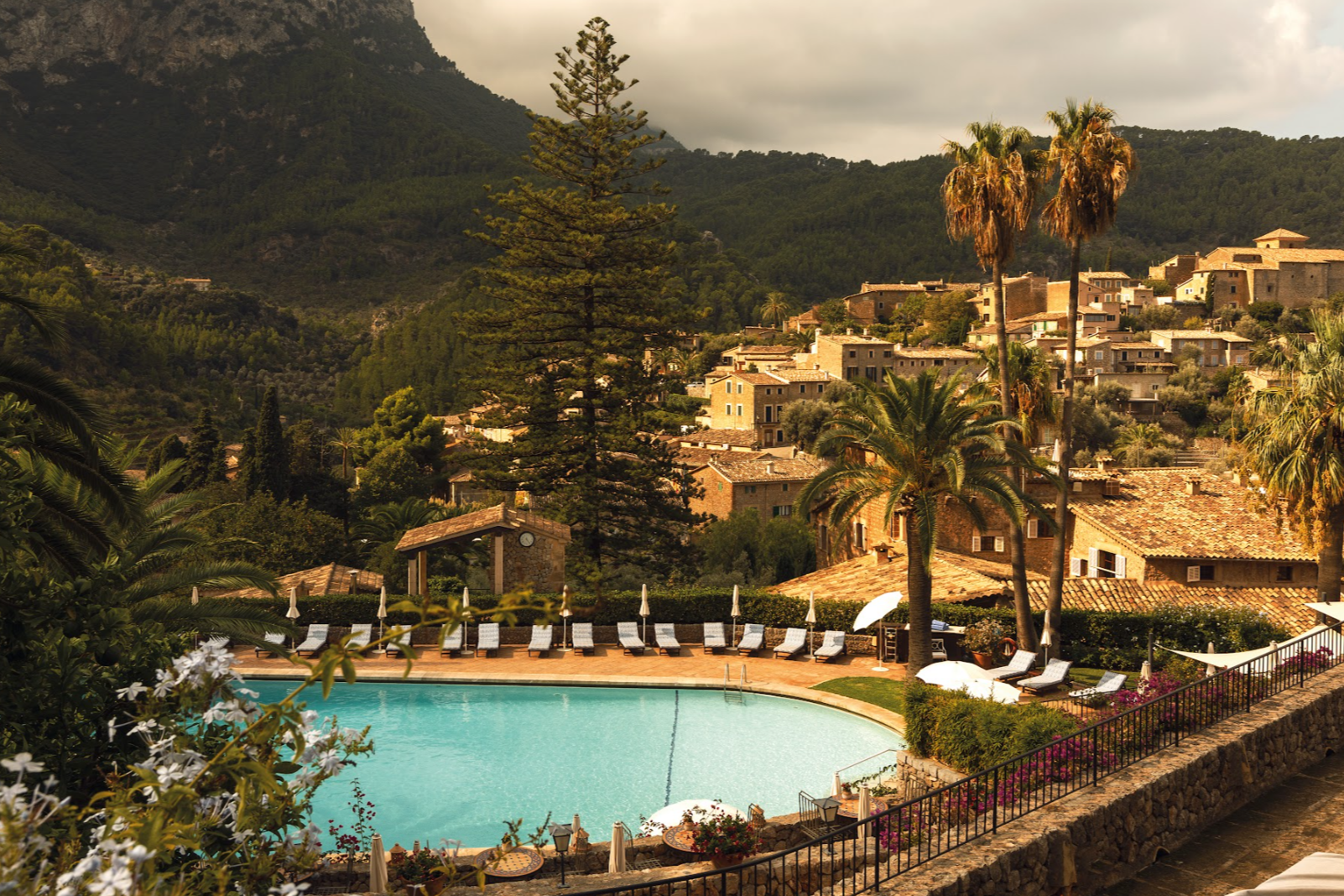
Image courtesy of La Residencia, A Belmond Hotel
Mallorca is famed for Palma’s historic streets and iconic Gothic cathedral. The Tramuntana mountains add to the island’s beaches for a beautiful landscape. Spend your days exploring local markets, hiking coastal trails or enjoying a wine tasting at a vineyard. The island offers a perfect mix of culture and relaxation, along with incredible hotels to stay at.
Where to stay
Sant Francesc Hotel Singular: This tranquil boutique hotel is set in a restored 19th-century mansion. Blending historic charm and modern elegance, rooms are stylish, the rooftop terrace has panoramic views and Michelin-starred dining make it stand out.
Fora Perks include a $100 food and beverage credit, daily breakfast, an upgrade and extended check-in/out whenever possible.
La Residencia, A Belmond Hotel: A peaceful retreat in Deià blending traditional Mallorcan architecture with contemporary rooms. The hotel’s gardens, spa, two outdoor pools and art collection make a uniquely refined yet relaxing stay.
Fora’s Belmond Bellini Club partner perks include a hotel credit, daily breakfast, an upgrade and extended check-in/out whenever possible.
Can Ferrereta: On the Southeastern coast in Santanyí, this boutique hotel is in a restored 17th-century manor house. Modern rooms, a small courtyard and a pool make it a great base to explore the town and surrounding area.
Jumeirah Mallorca: Located in picturesque Port de Sóller, this luxury hotel offers spacious contemporary rooms, a sea-view infinity pool and spa. The harbor is just a short walk, with beaches and hiking trails in the surrounding mountains nearby.
Fora Perks include a $100 food and beverage credit, daily breakfast, an upgrade and extended check-in/out whenever possible.
Menorca

Image courtesy of Menorca Experimental
Menorca is a more tranquil escape, with unspoiled beaches, charming harbors and historic towns like Mahón and Ciutadella. The island’s relaxed pace makes it ideal for a more leisurely exploration, strolling through town squares or unwinding by the sea. Its natural beauty and calm waters create the perfect escape, and there are some beautiful stays across the island.
Where to stay
Hotel Torralbenc: Set in a restored 19th-century farmhouse, this rustic retreat offers spacious rooms and a slower pace. A seasonal outdoor pool, farm-to-table restaurant and wellness area make it an understated island hideaway.
Fora Reserve perks include a $50 hotel credit, daily breakfast, an upgrade and extended check-in/out whenever possible.
Menorca Experimental: This boutique hotel blends modern minimalism with Menorcan tradition in a restored 19th-century farmhouse housing just 43 rooms plus nine private villas. There’s an infinity pool, herbal workshops and guided hikes to enjoy.
“This hotel perfectly captures the island's energy and feels like an artist’s retreat,” says Fora Advisor Hannah Lucas. “It’s festive yet peaceful, full of personality and a place that feels like an off the radar escape.”
Fora Perks include a 20 EUR food and beverage credit each day, welcome amenity and upgrade whenever possible.
Son Blanc Farmhouse Menorca: An eco-conscious retreat for those seeking a rustic, informal experience in Menorca. Set on a 15-acre property, the farmhouse hotel offers spacious rooms, locally sourced meals and nearby hiking trails and beaches.
Ibiza
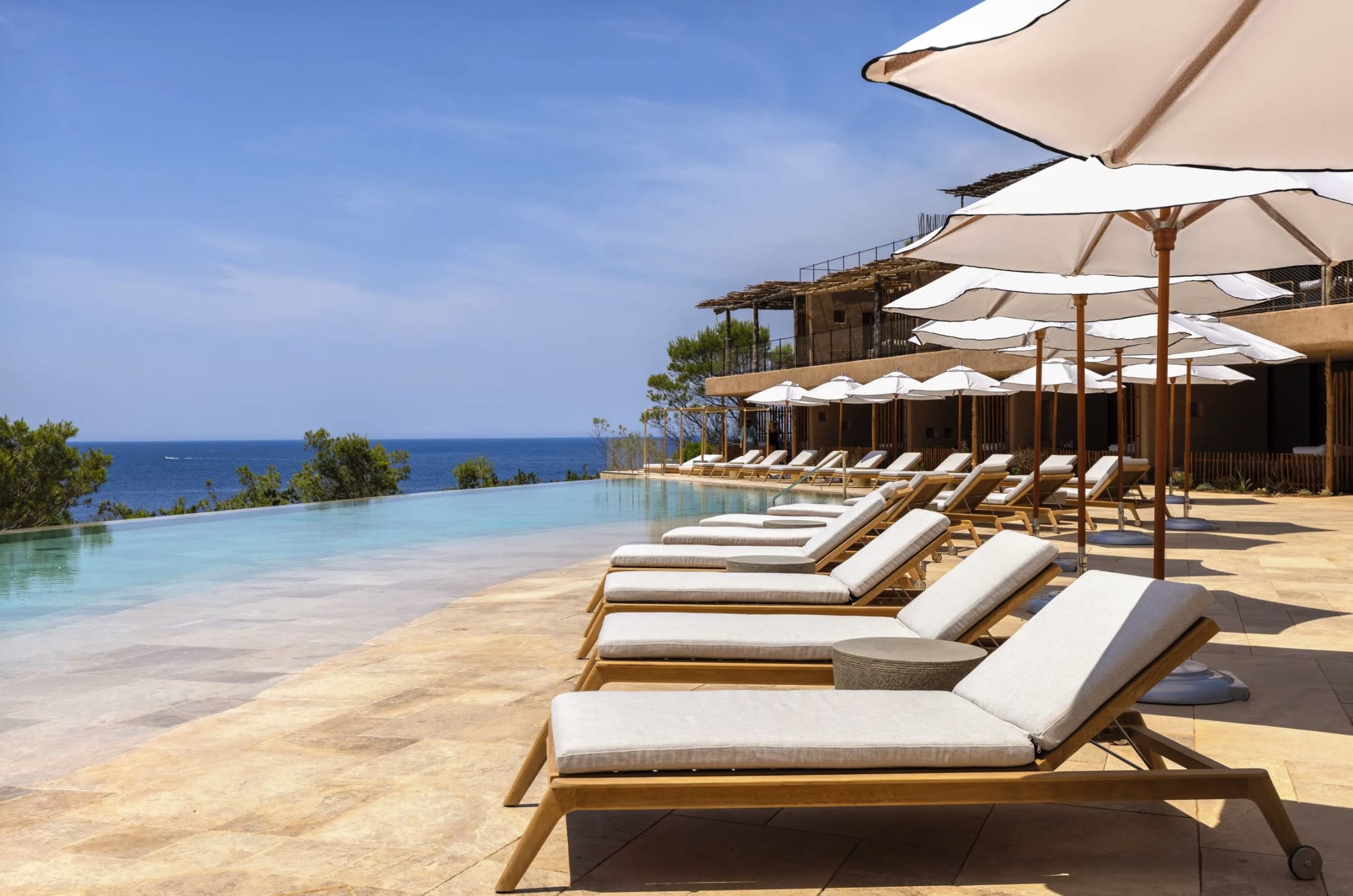
Image courtesy of Six Senses Ibiza
Ibiza is a nightlife capital, but it also offers rich history, scenic landscapes and a bohemian charm. Wander the UNESCO-listed Dalt Vila, browse artisan markets or explore hidden coves by day. At night, you can experience beachside nightclubs or a quiet evening at a seaside café. However you spend your time here, include a stay at one of these top picks.
Where to stay
The Standard Ibiza: This energetic adults-only hotel is in the heart of Ibiza Town. Modern rooms, a rooftop pool and buzzing communal spaces make it an unbeatable choice for a dynamic and effortlessly cool island escape.
Fora’s Standard Secret Agents partner perks include a food and beverage credit, daily breakfast, an upgrade and extended check-in/out whenever possible.
Six Senses Ibiza: A rejuvenating, eco-conscious escape for wellness seekers on the northern part of the island. Holistic spa treatments, organic farm-to-table dining and immersive wellness programs make it a sustainable and high-end hideaway.
Fora Perks include a $100 hotel credit, daily breakfast, an upgrade and extended check-in/out whenever possible.
7Pines Resort Ibiza: Sophisticated and relaxing, this all-suite clifftop resort offers privacy and comfort. The expansive spa, Mediterranean cuisine and private yacht charters elevate this laid-back luxury experience.
Fora’s Hyatt Privé partner perks include a $100 hotel credit, welcome amenity, daily breakfast, an upgrade and extended check-in/out whenever possible.
Formentera
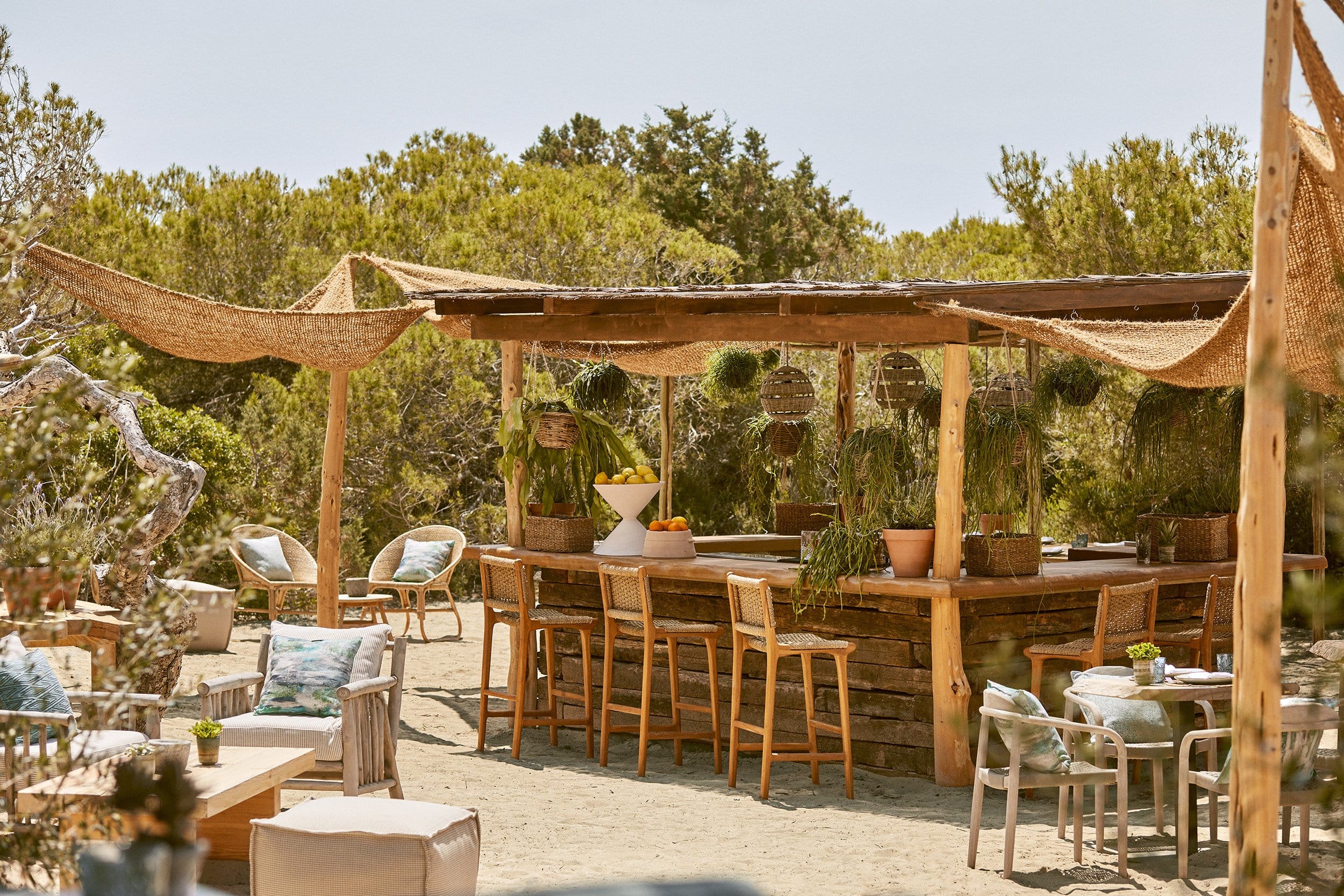
Image courtesy of Teranka Formentera
The most peaceful of the Balearic Islands, Formentera is the place to go for nature lovers and those who want to slow down. Cycle along coastal paths, snorkel in crystal waters, or simply relax on the beaches. With untouched beauty and a laid-back atmosphere, it’s the perfect place to unwind — and stay at some hidden gems.
Where to stay
Teranka: This laid-back, eco-conscious hotel offers a tranquil escape on Ibiza's coast. Blending natural materials, modern comforts and locally inspired elements, it’s the perfect luxury stay to relax and recharge while embracing the island's natural beauty.
Fora Perks include a $100 food & beverage credit, daily breakfast, an upgrade and extended check-in/out whenever possible.
Hotel Gecko and Beach Club: A stylish and laid-back pick with modern design, a sophisticated beach club and emphasis on wellness. It’s an ideal choice for those wanting contemporary elegance along with beachside relaxation.
Fora Reserve perks include a $50 resort credit, daily breakfast, an upgrade and extended check-in/out whenever possible.
Dunas de Formentera: This boutique hotel on the beach blends minimalist design with the island’s natural beauty. Spacious sea-view rooms, a pool and Mediterranean dining make it an intimate and charming stay.
Fora Reserve perks include a $100 resort credit, daily breakfast, an upgrade and extended check-in/out whenever possible.
History and culture
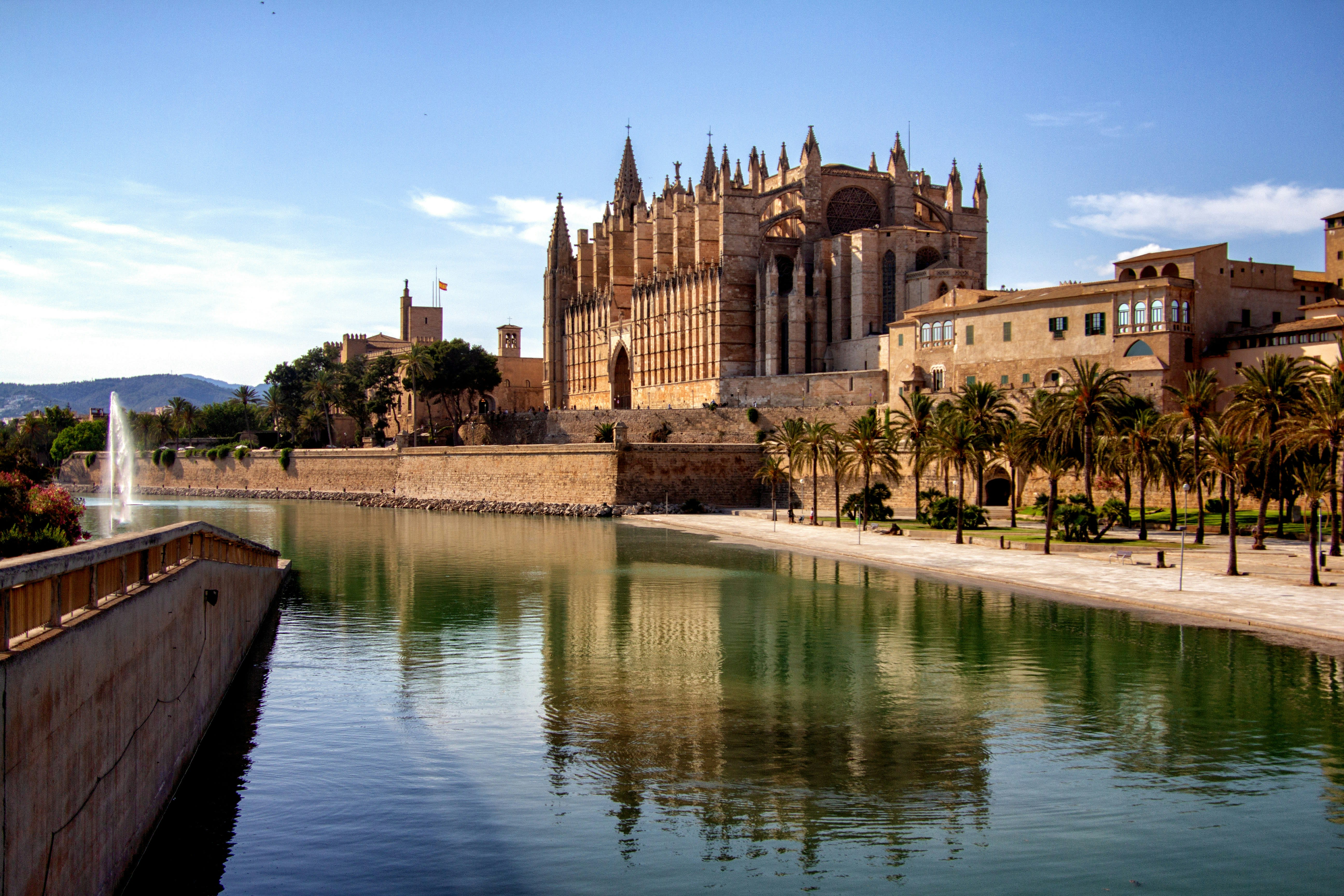
The Balearic Islands have a fascinating history shaped by centuries of influence from ancient civilizations to modern-day tourism. First settled by prehistoric peoples, the islands are dotted with megalithic sites like the Talaiots of Menorca, remnants of an ancient culture that still intrigue visitors today. The Phoenicians, Carthaginians and Romans all left their mark, with Palma’s Roman roots still visible in parts of the city. The Moors ruled for centuries, introducing advanced irrigation systems and architectural styles seen in landmarks like Palma’s Almudaina Palace. Later, the Catalan conquest in the 13th century brought Gothic architecture, best exemplified by La Seu, Palma’s stunning cathedral that overlooks the sea.
Today, deep-rooted traditions continue to thrive. The fiery Correfoc festivals feature costumed devils dancing with fireworks, while Semana Santa (Holy Week; the week for Catholics leading up to Easter Sunday) sees religious processions, especially in Palma and Mahon. Markets, folk music and island-specific dances like ball de bot reflect a proud cultural identity that locals cherish. Whether exploring the medieval streets of Ibiza’s Dalt Vila, the prehistoric Naveta des Tudons in Menorca or traditional festivals in small villages, travelers can experience the history woven into the fabric of the Balearic Islands.
Activities

Image courtesy of The Standard Ibiza
The Balearic Islands offer a mix of relaxation, adventure and cultural experiences. Travelers can explore historic towns, hike along scenic coastal trails or unwind on pristine beaches. Outdoor enthusiasts can enjoy watersports, while food lovers can visit local food markets.
Mallorca
Shopping: Shop luxury brands like Louis Vuitton and Escada along Jaime III in Palma, or browse popular stores such as El Corte Inglés and Maje.
Old Town Palma: Stroll through Palma’s Old Town to find boutiques, cafés and local artisan crafts.
Food markets: Sample fresh Mallorcan produce and traditional delicacies at Mercado de Santa Catalina or Mercado de l’Olivar.
Movies and music: Catch an outdoor movie at Paseo Marítimo or enjoy a classical concert at the Son Marroig estate.
Beaches: Unwind on the beaches of Cala Deià or the tranquil Cala Llombards cove.
Hiking: Hike to Sa Foradada for views of the coast, visit Mondragó Natural Park or Boquer Valley for wildlife sightings, or walk the scenic trail from Deià to Sóller.
Tours: Take a guided tour to visit the wineries in the Binissalem region or visit the Ses Salines Salt Flats.
Landmarks: Visit the Gothic-style La Catedral de Mallorca and learn about Mallorca’s royal heritage at the Royal Palace of La Almudaina.
Museums: The island is filled with galleries, studios and museums to explore every style of art. Some of the highlights include modern and contemporary art at the Es Baluard Museum, works of Joan Miró at the Fundació Pilar i Joan Miró, sculptures and paintings at the Palau March Museum, and contemporary exhibits at La Caja Blanca.
Sant Sebastià Festival (January): Palma’s winter festival honoring its patron saint with fireworks, concerts and traditional bonfires.
Nit de l’Art (September): The biggest contemporary art event on the island, where galleries and museums host special exhibitions.
Menorca
Villages: Wander the cobblestone streets of charming villages like Ciutadella and Mahón, where you’ll find boutique shops, galleries and bustling markets.
Hiking: Explore the scenic Cami de Cavalls trail, which circles the island’s rugged landscapes.
Art: Experience Menorca’s cultural scene with contemporary art at LÔAC- Centre d'Art or visit artisan workshops like Sense Nom in Alaior.
Historic sites: Step back in time at historic landmarks like the 18th-century fortress of La Mola or the prehistoric Talaiotic village of Torre d'en Galmés. Take in gorgeous views at the historic Cape Cavalleria Lighthouse, at the northern tip of the island.
Beaches: Relax and enjoy the clear waters of the island’s beautiful beaches. Some of the best are: Cala Mitjana (surrounded by cliffs), Cala Escorxada (a hidden gem, accessible by foot or boat), Cala Pilar (a remote golden sand beach), Cala Pregonda (known for its striking red sand), Cala en Brut (secluded with rocky coves), Cala Mitjaneta (quieter and more intimate) and Caló Blanc (small and tranquil with calm waters).
Ibiza
Dalt Vila: Stroll through Ibiza’s historic old town, Dalt Vila, where panoramic views and centuries of history await.
Sunsets: Experience the famous Ibiza sunsets along San Antonio’s Sunset Strip at a variety of bars and restaurants.
Beaches: Relax on Ibiza’s diverse beaches, from the energetic Playa d’en Bossa to the tranquil coves of Cala Comte.
Boating: Take a boat tour of the coastline to visit hidden beaches and dramatic cliffs.
Nightlife: Immerse yourself in Ibiza’s legendary nightlife, from chic beach clubs to iconic venues like Pacha and Amnesia.
Carnival of Ibiza (February / March): A lively parade with elaborate costumes, music and dance marking the start of Lent.
Ibiza Jazz Festival (September): An annual event showcasing international and local jazz talent in Ibiza Town.
New Year's Eve (December 31): A mix of vibrant beach parties, exclusive club events and fireworks over Ibiza Town, marking the start of the new year in true Balearic style.
Formentera
Beaches: Unwind on the island’s beaches like Ses Illetes, known for crystal-clear waters and soft white sand.
Seeing the island: Rent a bike or scooter to take scenic routes through untouched landscapes and picturesque villages across Formentera.
Galleries: Visit local art galleries like the Formentera Art Centre for contemporary works from both international and local artists.
Boating: Take a boat trip to Es Vedrà, an island with dramatic views, and see coastal sites like La Mola Lighthouse.
Can’t decide? Consider a cruise…
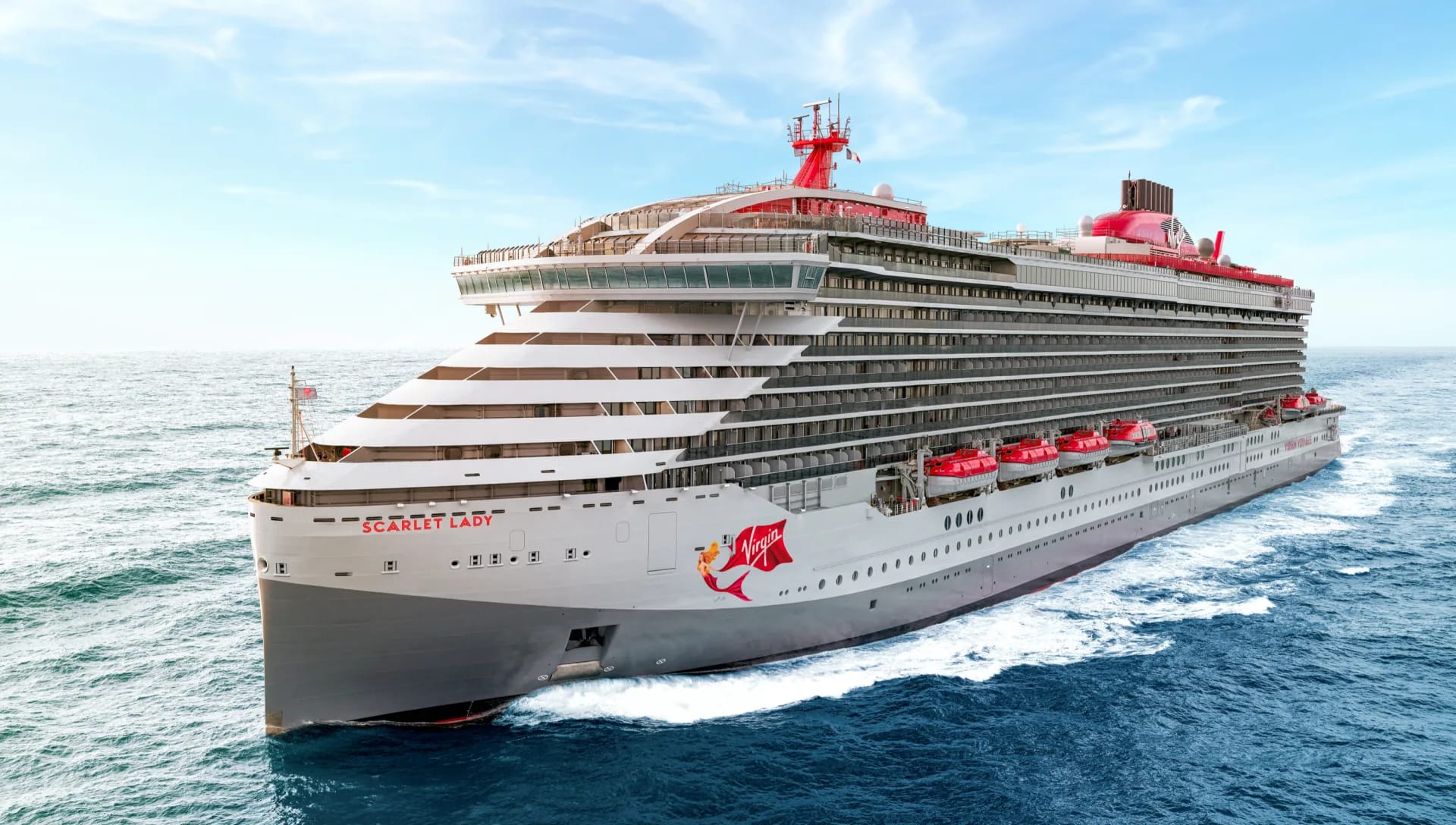
Image courtesy of Virgin Voyages
Because each island offers their own unique experiences, it’s tough to pick just one. A great way to see multiple islands is by taking a cruise. Several cruise lines specialize in sailing around the Balearic Islands, but these are a few favorites.
Emerald Cruises: Explore the Balearic Islands in style with this seamless way to experience Mallorca, Menorca, and Ibiza — all without the hassle of unpacking. With an intimate atmosphere and elegant design, it’s a perfect choice for couples who are looking for a romantic getaway.
Explora Journeys: Catering to families and multi-generational travelers, these ships feature spacious connecting suites and a dedicated club for younger guests. Their curated Destination Experiences provide cultural and adventure-filled activities for all ages.
Virgin Voyages: With a signature high-energy vibe, this adults-only cruise line features late-night and overnight stays in Ibiza. Travelers get plenty of time to experience the island’s legendary nightlife with stylish accommodations, world-class dining and a lively on-board social scene.
Trips to add on

Extend a trip to the Balearic Islands with a visit to another Mediterranean destination or an urban stop. Whether you're craving more coastal beauty, rich history or incredible cuisine, these nearby spots make for the perfect addition.
Valencia, Spain (50 minutes by plane or 5 hours by ferry): The birthplace of paella, Valencia blends modern design with historic charm along the Mediterranean coast.
Barcelona, Spain (1 hour by plane): A major city famous for Gaudí’s architecture, world-class dining and a lively beach culture.
Costa Brava, Spain (1.5 hours by plane via Barcelona): A scenic region dotted with hidden coves, medieval villages and a renowned food scene.
Marseille, France (1.5 hours by plane): A historic port city with stunning sea views, vibrant markets and the dramatic landscapes of the Calanques.
Sardinia, Italy (1 hour by plane): A Mediterranean gem known for its turquoise waters, rugged coastline and fascinating ancient ruins.
London, UK (2 hours by plane): Direct flight options make London an exciting and easily accessible city escape. Renowned museums, iconic landmarks, high-end shopping and a diverse culinary scene are just some things to enjoy.
Frankfurt & Munich, Germany (2 hours by plane): Direct seasonal routes make these German cities the perfect addition. Discover historic sites, picturesque old towns and festive seasonal markets.
If not the Balearic Islands…
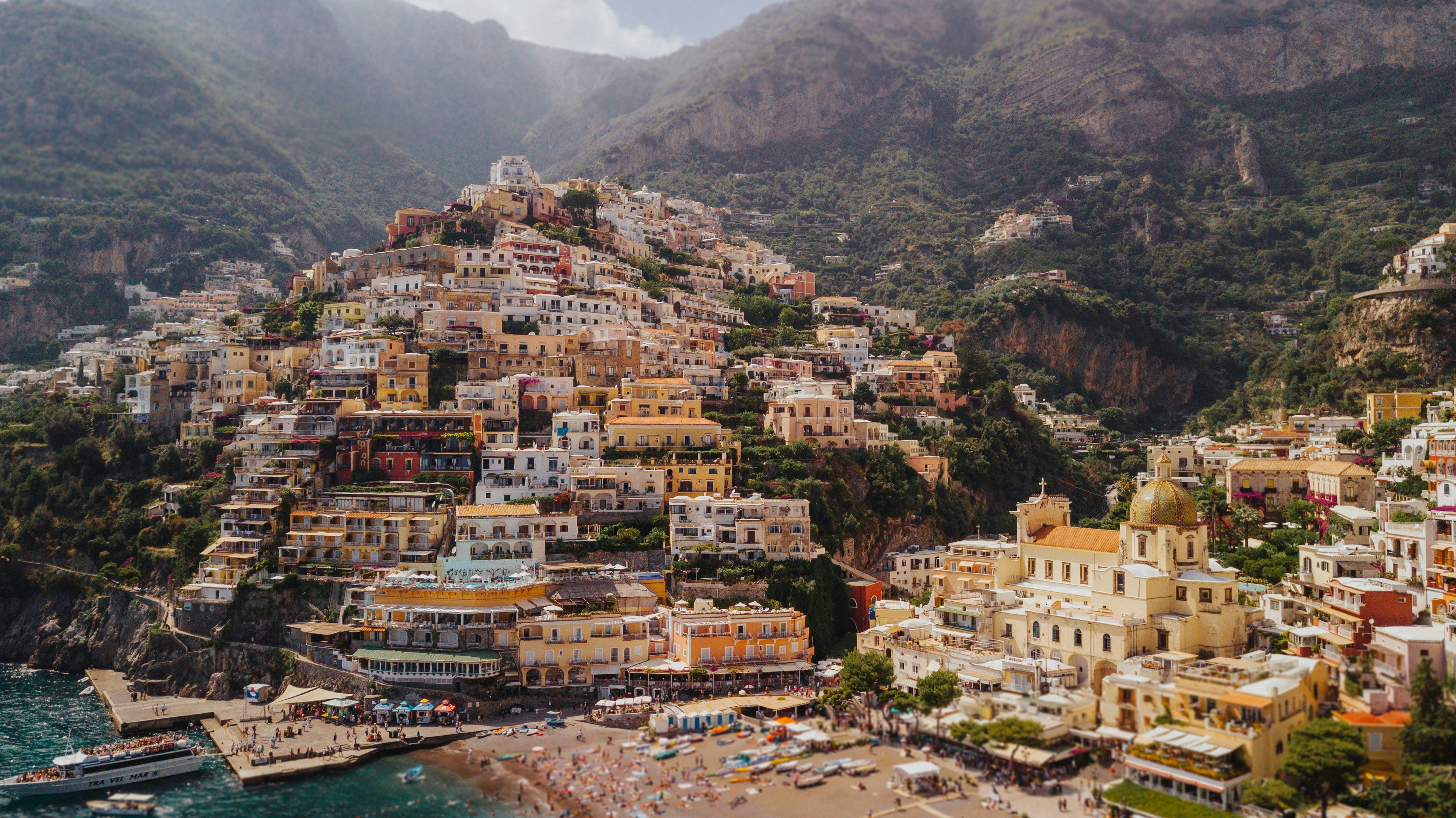
If you love the Balearic Islands’ stunning beaches, rich culture and relaxed style but want a different choice of scenery, these destinations offer a similar charm with their own unique appeal.
Amalfi Coast, Italy: A glamorous stretch of coastline with colorful cliffside villages, hidden coves and some of Italy’s finest cuisine.
Azores, Portugal: A paradise for nature lovers, featuring volcanic landscapes, crater lakes and soothing geothermal hot springs.
Paros, Greece: A Cycladic gem with charming whitewashed villages, golden beaches and a lively yet laid-back island atmosphere.
Dalmatian Coast, Croatia: Sail through medieval coastal towns like Dubrovnik and Hvar, discovering secluded islands and crystal-clear waters.
French Riviera, France: Chic seaside destinations like Saint-Tropez and Cannes, known for luxury yachts, high-end dining and sun-drenched beaches.
French Basque Coast (San Sebastián & Biarritz): A perfect mix of Basque culture, world-renowned food and Atlantic beaches, offering a mix of elegance and surf-town charm.
